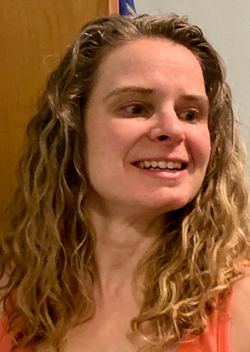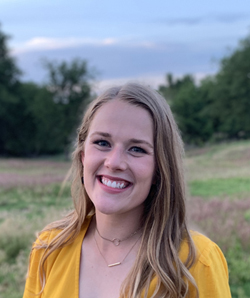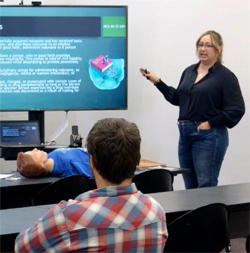UM Public Health Students Earn Award to Study Major Issues in Montana
By Kyle Spurr, UM News Service
MISSOULA – Five public health master’s students at the University of Montana are working on projects that tackle some of the largest health issues facing the state and region.
The students in UM's Masters in Public Health with Community Health and Prevention Sciences Concentration recently earned the regional Student Leaders in Public Health Award from the Rocky Mountain Public Health Training Center in the Colorado School of Public Health. The award provides $3,500 to each project.
In past years, UM’s public health school saw one to two students receive the regional award. Having five earn the award this year is unprecedented and a testament to the caliber of the students, said Rachel Peterson, an assistant professor in UM’s School of Public and Community Health Sciences.
The students have immersed themselves in projects that affect all corners of Montana. Their projects look at a connection between health and access to food in Indigenous communities, how to mitigate mosquitoes in Fort Benton, an analysis of public health worker salaries, the effect of wildfire smoke on residents in western Montana and a program to protect individuals during an opioid overdose.
The students’ projects also are a requirement for them to graduate and necessary to maintain the public health school’s accreditation. “We currently offer the only accredited public health degrees in Montana and provide one of the few accredited public health programs in the region,” Peterson said.
The UM students and their project topics follow:

Sarah Black, who graduated with her master’s degree in December and continues to work as a research assistant at UM with Dr. Blakely Brown, is examining the relationship between various health factors and access to food among Indigenous populations.
Black, who grew up in Helena and now works as a nurse at the Missoula City County Health Department, began her project in January 2022. Her research is part of a larger study focused on families and access to nutrition support programs. The larger study originates from a partnership between All Nations Health Center in Missoula and Urban Indian Health Centers in Great Falls and Billings.
“This is almost a silly question: Does food security affect your health status?” Black said. “Yes, it does. Let’s make sure everyone is fed and healthy. But part of the work is to answer those questions and dig more specifically.”
To dig deeper, Black analyzed responses from interviews and a 12-question survey about general health and food security. The survey was sent to people who were recruited by the three Urban Indian Health Centers.
Traditionally when Native communities are studied, the study focuses on reservations and not Native Americans living outside reservations, Black said, and she believes it’s a strength to include urban Native Americans.
Black is still working through the data, but plans to compare the results to other studies and send the findings back to the Urban Indian Health Centers.
“We want it to be something that is useful and helpful for them,” Black said.

Ali Manuel, a second-year master’s student from Shingle Springs, California, is working with residents in Fort Benton to build habitats and community support to control the mosquito population, which is a major nuisance in central Montana.
The Fort Benton community currently uses insecticides to remove the mosquitos. Insecticides are safe for humans but can have a negative impact on the ecosystem, Manuel said. To reduce the use of insecticides, she found another way to decrease the mosquito population: bats.
Manuel, who has a bachelor’s degree in biology with a concentration in zoology from San Francisco State University, plans to teach Fort Benton residents about bats and encourage them to increase bat habitat since the flying mammals are known to feast on mosquitos. Manuel is familiar with bats from working as an animal research technician at the University of California, Berkeley.
“I have some experience working with bats from my time at UC Berkeley,” she said. “They are an important part of getting rid of insects and an important part of the ecosystem.”
Later this year, Manuel will host an event to build bat boxes with local families and educate them about other ways to reduce mosquitoes such as removing standing water and cleaning out rain gutters.
Manuel partnered on the project with Kelly Engen, an education master’s student from Western Governors University in Utah, who grew up in Fort Benton and alerted Manuel to the mosquito problem.
Along with the bat boxes, Manuel and Engen have asked local business owners for permission to install “bat mansions,” which are larger versions of the bat boxes. They hope to install one near the water treatment plant.
“The town itself is so engaged in this problem and is interested in a solution,” Manuel said. “That is really helpful.”

Portia O’Connell, who will graduate this May with her master’s degree, is analyzing the salaries of public health workers in local and tribal health departments across Montana.
“The ultimate goal is to provide fresh data to assure public health is providing competitive salaries to recruit and maintain a well-qualified workforce,” she said.
O’Connell, who grew up in Gresham, Oregon, began her research last summer by reading other salary studies and diving into a 200-page document of Montana public health standard occupational classification codes. The document details job descriptions and pay for all public health positions such as epidemiologist, public health nurses and environmental specialists.
O’Connell also reached out to all 56 county health departments in Montana to see if their salaries matched what was listed in the 200-page state document. So far more than 30 counties have responded. From the initial data, O’Connell has seen larger health departments pay similar to the state recommendation, while smaller departments often pay less.
The study was motivated by a trend of public health graduates seeking work in the private and nonprofit sectors rather than public health fields, O’Connell said.
“One of the things we’ve noticed is there are a lot of vacancies in public health and there’s a lot of people who have graduated and they are not going into the local health department sector,” O’Connell said.
Once her project is finished, the findings will be shared across the state to help public health departments set competitive pay.
“The hope is that each of those counties will be able to take this study back with them and talk to their county commissioners and show them they are not up to par with what they should be paying their employees,” O’Connell said. “And hopefully it will lead to some policy change and salary increases.”

Taylor Stewart, a second-year master’s student from Gardner, Kansas, who will graduate this May, is evaluating the connection of wildfire smoke exposure and health in residents across western Montana.
Stewart’s project evolved from her role as a research assistant on a pilot study under Ethan Walker, an assistant professor in UM’s Center for Population Health Research. In the study, 20 participants across the region were given PurpleAir monitors, a low-cost air monitor about the size of a grapefruit, to record real-time data from June to October last year. The participants also were given weekly health questionnaires.
“This is a study that enabled us to see what air quality looks like at a hyperlocal and household level,” Stewart said. “Montana is a really big state and we have a limited amount of air quality monitors.”
Since receiving the award, Stewart has completed end-of-study interviews to evaluate feasibility of remote and real-time air quality studies and better understand participant behaviors and beliefs about wildfire smoke exposure and health. As Stewart analyzes the results, she’s noticed changes in participants’ behaviors such as a person closing their windows when the air quality monitor showed unhealthy levels.
“I didn’t come about this project thinking much about citizen science, but after conducting these interviews I’m realizing in a lot of ways data access is power,” Stewart said. “People who have air quality data access to their own homes are making decisions based on that.”
Stewart’s goal is to take the findings and use it for future studies that specifically target cardiovascular patients and those in rural and more vulnerable environments. Her work has inspired her to keep studying air quality and its effects on people and the planet.
“It’s been an impactful experience,” Stewart said. “It’s allowed me to realize that is the field of work I’m interested in pursuing post-graduation.”
Brandi Williams is a second year Masters in Public Heath student graduating in May from Havre and she used her award to create a Narcan Distribution Program for the Hill County Health Department.
Williams created a presentation and conducted a training to ensure first responders, law enforcement and community members could protect individuals during an opioid overdose by safely dispensing Narcan – a medicine used during opioid overdose emergencies.

“Being passionate about public health, I wanted to ease concerns about Narcan use,” Williams said.
Williams used her trainings to break misconceptions about using Narcan in a life-saving situations, as well as teach the public about opioid use and how Narcan works to prevent fatalities.
Throughout the course of her work, Williams trained 153 individuals and distributed 200 boxes of Narcan across northcentral Montana.
“I want the people I taught to go out and be advocates,” Williams added. “I want them to have an education they can use in the future.”
Since concluding her work for the Hill County Health Department, Williams now serves as an epidemiologist for the Benton Franklin Health District in Washington.
###
Contact: Dave Kuntz, UM director of strategic communications, 406-243-5659, dave.kuntz@umontana.edu